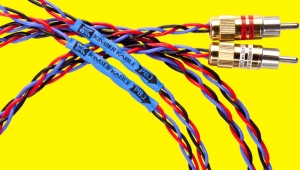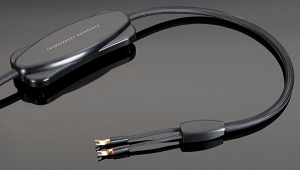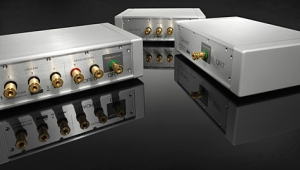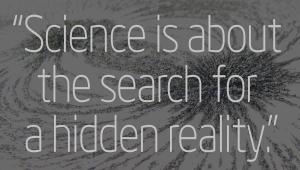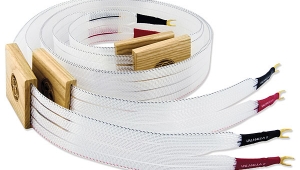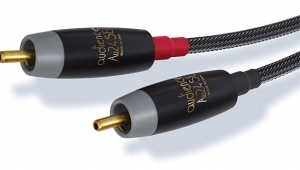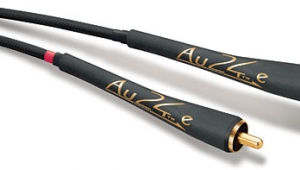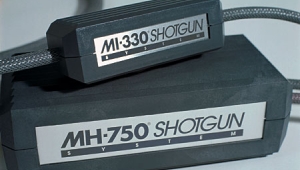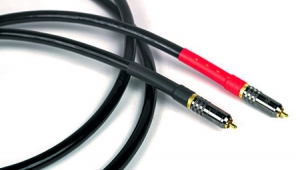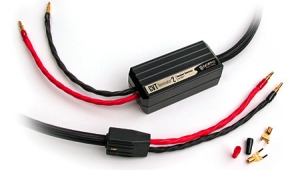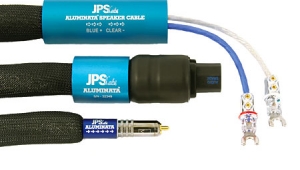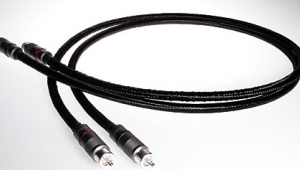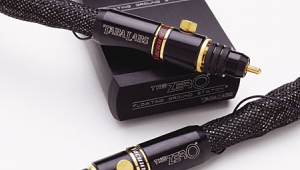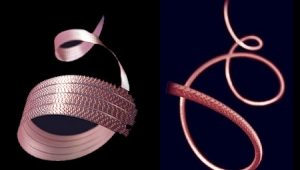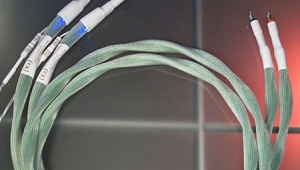| Columns Retired Columns & Blogs |
Harmonic Technology CyberLight Wave & P2A interconnects
When no one's watching, it's easy to express your opinion. When tens of thousands of people are reading over your shoulder, it becomes more difficult. In fact, it can be downright creepy—especially when what you're thinking sounds like one of those grand, all-encompassing (over)statements you yourself tend to distrust. You don't want to be wrong; on the other hand, if you're too much of a wuss to express what you reallythink just because someone might take it as grandiose, then it's time to give up.
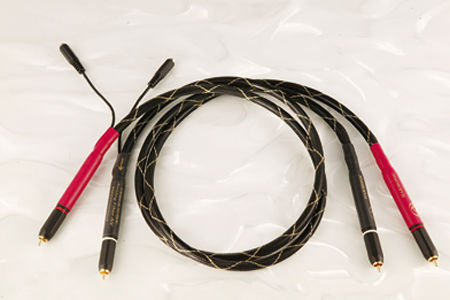
Having watched other audio writers descend into hyperbole hell when revolutionary new technologies such as the transistor and the compact disc were introduced to high-performance audio, for a few months now I've sat on my opinion of Harmonic Technology's new laser-driven, fiber-optic analog and digital cables.
I'm not yet ready to give up, but I am prepared to risk jumping into hyperbole hell. I believe that what I think now, and have thought almost since I first installed Harmonic Tech's new CyberLight Wave and P2A LAM cables in my system, is true: The CyberLights represent one of the greatest technological breakthroughs in high-performance audio that I have experienced in my audiophile lifetime. Gulp.
What it is and isn't
Basically, Harmonic Technology's Light Analog Module (LAM) Photon Transducer is a tiny module built into the cable right at the RCA or XLR plugs. The LAM converts voltage to laser light, which is then transmitted via audio-grade glass fiber to a receiver in line with the RAC or XLR plug at the other end of the line, which converts the light back to voltage. Once the conversion to light has taken place, the light moves at, of course, the speed of light (ca 186,000 miles per second), with no resistance, capacitance, "skin effect," inductance, RFI or EMI reception, etc. You needn't worry about crossed power cords or static electricity; dressing cables to prevent induced hum or keeping them off the floor become nonissues. In fact, Harmonic Tech claims no signal loss of any kind in cable runs of up to 200 meters. And with no conductive wires between components, all potential ground loops are eliminated.
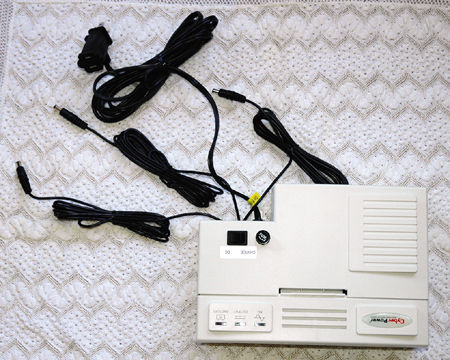
There is no digital conversion, nor is amplitude or frequency modulation involved. The process is purely analog. Because the signal is unidirectional, there is no back-reflectivity of the signal. The system bears no relationship to LED-based TosLink transmitters. Instead, true telecom/broadcast-quality analog laser technology is used at an invisible wavelength. According to Harmonic Technology, every electron that enters a Light Analog Module is converted to a photon, then back to an electron at the receiver end. The cables are available with either single-ended RCA or balanced XLR terminations. Imagine the advantages of this stuff used as balanced microphone cables.
Both sinewaves (analog) and squarewaves (digital) can be transmitted. The input/output impedance of the CyberLight Digital Datalink is 75 ohms (the balanced XLR is 110 ohms). The analog cable's input impedance is a high 30k ohms, the output impedance a low 75 ohms, thus making it component-friendly at both ends.
The key issue is how accurately Harmonic Tech's miniature LAM Photon Transducer converts the signal to light and how effectively the receiver reconverts it. That I couldn't measure. I could go only by what I heard, though HT claims a bandwidth that's flat from 5Hz to 30MHz.
Logistics, setup, use
There are three varieties of CyberLight Wave cables: CyberLight Wave for source to preamp, CyberLight P2A for preamp to amp and source direct to amp, and CyberLight Digital Datalink for digital source to D/A converter. The standard versions accept ±2.5V signals; ±4.25V and ±6V versions are available as special orders. I used a pair of 20' P2As between my preamp and amp, and 1.5m pairs of Waves from CD player to preamp and phono preamp to preamp.
The LAMs are powered cables, so wall-wart power is standard; each set of cables comes with its own wart. Far more preferable is the Cyber Power Pack ($399), a rechargeable battery that remains plugged in at all times. Power connection is via "pigtails" that extend from near the transmitter end of each P2A and from the receiver end of each CyberLight Wave. The power source connections for both thus remain close to the source jacks.
To use the CyberLights, charge up the battery for at least 18 hours (preferably 24), then shut your system down, install the cables, and connect the power—Harmonic supplies power Y-connectors so that one line from the Power Pack can control two cables. Then switch the Pack from Charge to DC, fire up your system, and you're ready to play for up to maybe eight hours, until the Pack needs a recharge. When you're finished listening, shut off your amp and flip the Pack's switch back to Charge. The downside is that you can't leave your solid-state amp on continually. And don't ever unplug or plug in the power to the cables with the amplifier turned on or you'll send a horrendous THUMP through your system.
Once it's up and running, using the CyberLight cable system is easy, as long as you remember to shut off your amp and flip the Power Pack's switch to Charge; otherwise, you'll have no sound for your next listening session and will have to switch to the wall warts. If you're listening when the battery is almost drained, you'll know it. The sound will become most foul, distorted, and anemic.
The most fabulous sound
When you're powered up and ready to play music, you'll hear a very slight hiss coming from the speakers. If this freaks you out, no CyberLight cables for you. But the hiss is low and residual; it won't increase in level as you turn up the volume. Believe me—it's a nonissue. As for what you'll hear . . .
If you hear what I heard, for the first time in your life you'll hear no cables whatsoever. When you switch back to any brand of metal conductors, you'll know you're hearing cables—because what's transmitted via CyberLight will be the most gloriously open, coherent, delicate, extended, transparent, pristine sound you've ever heard from your system—at least if you hear what I heard.
There was a delicacy and purity to high-frequency transients that was immediate and unmistakable. By comparison, going back to regular cables made everything sound bright or dull or spotlit or hard, depending. The CyberLights produced an effortlessness and a pulse-like coherence that was more "musical" than anything else I've experienced while listening to recorded music. The bass was ultratight and round and "right," and the harmonic balance and overall musical decay were more natural and believable than I'd ever heard from any stereo system.
The LAM technology might—I say might—have had a particular character or sonic signature that could be described as a slightly glassy smoothness, but I think it was just the absences of grunge and metal cables' well-known problems—the problems that all cable designers tout their cables as having eliminated. Harmonic Tech has eliminated those problems for real by eliminating the cables themselves. If there was a slight tradeoff—and I'm still not saying there was—whatever was lost was more than made up for by what the CyberLights provided.
A number of serious cable skeptics within the high-end industry have visited me in the past few months. After listening sessions in which we made many cable swaps and A/B comparisons, they came to the same conclusions I have about the clear superiority of naturally musical presentation the LAM technology provides.
Summing Up
Having spent several months with the CyberLight analog interconnects (I haven't yet checked out the Digital Datalinks): 1) I would not want to be in the business of making expensive standard cables right now; 2) Harmonic Technology's Light Analog Module Photon Transducer is the most significant single technological breakthrough I have experienced in my career as an audio reviewer. It is immediately superior in every way.
Might measurements show signal degradation? Might someone come up with a way of "proving" that the LAM process induces a serious coloration even as it removes many others caused by conventional signal transmission? Perhaps—and I'm sure every other cable maker will be looking for those proofs.
Me? I'm prepared to eat crow. No matter how I try to deny it, after many months of listening to these cables with a wide range of associated gear, their superiority to anything else out there that I've heard is undeniable. This superiority comes at a fairly stiff price, but if you can afford it, I don't think you'll be disappointed.
- Log in or register to post comments
